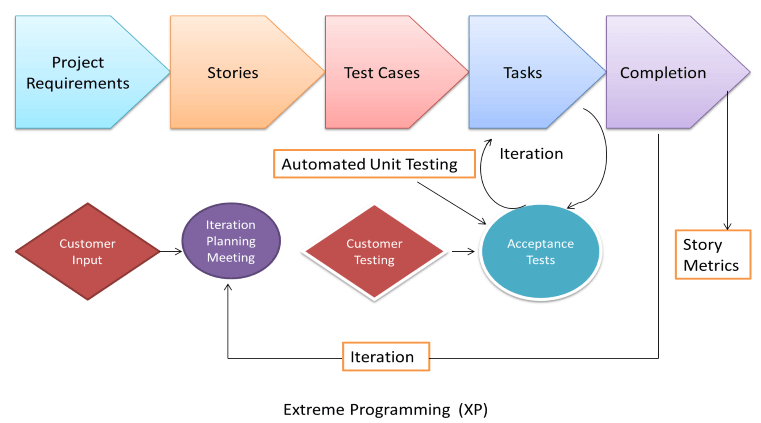eXtreme Programming (XP)
Extreme Programming technique is very helpful when there is constantly changing demands or requirements from the customers or when they are not sure about the functionality of the system. It advocates frequent "releases" of the product in short development cycles, which inherently improves the productivity of the system and also introduces a checkpoint where any customer requirements can be easily implemented. The XP develops software keeping customer in the target.
Business requirements are gathered in terms of stories. All those stories are stored in a place called the parking lot.
In this type of methodology, releases are based on the shorter cycles called Iterations with span of 14 days time period. Each iteration includes phases like coding, unit testing and system testing where at each phase some minor or major functionality will be built in the application.
Phases of eXtreme programming:
There are 6 phases available in Agile XP method, and those are explained as follows:
Planning
- Identification of stakeholders and sponsors
- Infrastructure Requirements
- Security related information and gathering
- Service Level Agreements and its conditions
Analysis
- Capturing of Stories in Parking lot
- Prioritize stories in Parking lot
- Scrubbing of stories for estimation
- Define Iteration SPAN(Time)
- Resource planning for both Development and QA teams
Design
- Break down of tasks
- Test Scenario preparation for each task
- Regression Automation Framework
Execution
- Coding
- Unit Testing
- Execution of Manual test scenarios
- Defect Report generation
- Conversion of Manual to Automation regression test cases
- Mid Iteration review
- End of Iteration review
Wrapping
- Small Releases
- Regression Testing
- Demos and reviews
- Develop new stories based on the need
- Process Improvements based on end of iteration review comments
Closure
- Pilot Launch
- Training
- Production Launch
- SLA Guarantee assurance
- Review SOA strategy
- Production Support
There are two storyboards available to track the work on a daily basis, and those are listed below for reference.
- Story Cardboard
- This is a traditional way of collecting all the stories in a board in the form of stick notes to track daily XP activities. As this manual activity involves more effort and time, it is better to switch to an online form.
- Online Storyboard
- Online tool Storyboard can be used to store the stories. Several teams can use it for different purposes.


No comments:
Post a Comment